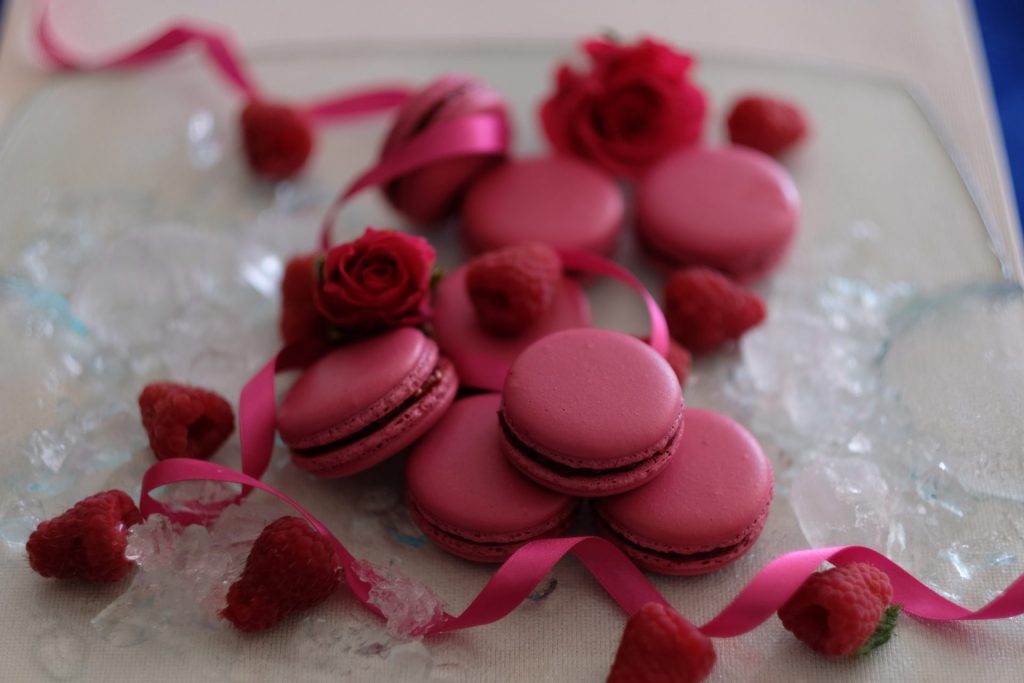French Macarons, Products
Scottish Raspberry Macarons
Raspberries, fruit of the Olympian Gods
An ancient legend has it that raspberries, actually part of the rose family, were originally a white fruit. The story goes that the nymph Ida, daughter of a King of Crete, nursed the god Zeus when he was a baby. One day he was upset and crying, and she thought a raspberry would help to calm him. So she picked one of the white fruits. But while doing so, the sharp thorns of the raspberry pricked her breast and her blood transformed the raspberry to the deep pinkish red that we know today. In fact the most commonly eaten variety today is named after Ida – Rubus idaeus.


What’s in a name?
The more familiar name, raspberry, has a number of possible origins. It may be a misrepresentation of the term “wild strawberry”; or be from the word raspise, which was a sweet rose-colored wine (mid-15th century); or from raspoie, meaning “thicket”, of Germanic origin; or, because of its roughness, the name may have come from the Old English word rasp or “rough berry”.
The raspberry rainbow
As well as red or white, raspberries can be black, purple, yellow, orange or amber. Wild varieties have grown in Europe and north Asia for millennia and wild red raspberries can be found today, often in wooded areas, in many parts of the UK. Raspberries have probably been cultivated for at least 2000 years and now there are multiple varieties available to growers. Depending on the variety, some raspberries fruit twice a year in June and September but others are either summer fruiting or autumn fruiting. The summer fruiting varieties bear fruit on woody stems (canes) from the previous year whereas autumn varieties bear fruit on first year canes.
The raspberry fruit is actually made up of about 100 small drupelets, which are individual seeds each surrounded by sweet flesh. They are arranged in a helmet shape on the small, centrally positioned stem. When a ripe raspberry is picked, it comes off the stem which remains on the mother plant, resulting in the hollow fruit we are familiar with.
So healthy!
Among fresh fruits, raspberries have one of the highest contents of beneficial minerals, providing more than 1300 mg of minerals per 100 kcalories. As well as other necessary elements, they contain remarkable levels of magnesium (53 mg/100 kcalories), calcium (58 mg/100 kcalories) and iron (1.8 mg/100 kcalories) and so contribute effectively to meeting the body’s needs.
The same is true for vitamin C (ascorbic acid): a 100 g serving of raspberries provides 25 mg, more than half of the UK recommended daily intake. Vitamin C is an essential part of our diet – our body uses it to help repair tissue; it benefits our nervous system; and it is used to prevent and treat scurvy. Vitamin C levels decrease rapidly after a fruit is harvested but for raspberries this is not a problem as, because they don’t keep very long, they are normally eaten soon after harvesting anyway. So when you eat fresh raspberries, you always get the maximum amount of vitamin C!
The helpful antioxidant
Vitamin C is an antioxidant, a compound that inhibits oxidation (a chemical reaction that can produce free radicals and chain reactions that may damage the cells of organisms). Other antioxidants in raspberries include anthocyanins (which give the fruit their red or purple colour), gallic acid and ellagic acid. Thanks to these molecules, fresh raspberries can help prevent certain cancers (colon, breast, liver, prostate, oesophagus, mouth, cervix), cardiovascular diseases, and other so-called lifestyle diseases (prevalent in high and middle-income countries and caused partly by unhealthy diets).
A blissful partnership
Raspberries are clearly a wonderful and extremely healthy fruit. We at 7Marvels have chosen the delightfully named “Autumn Bliss” variety of raspberry, grown extensively in Scotland, for our macarons. It produces large, very tasty fruits whose aromatic, slightly tangy flavour is excellent and complements the sweetness of the macarons.



